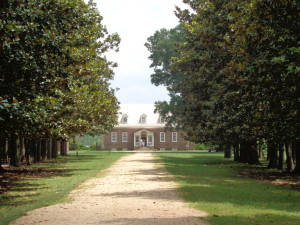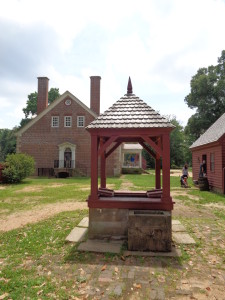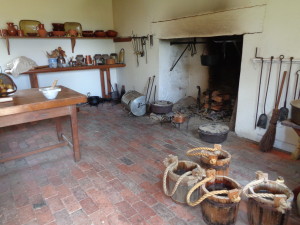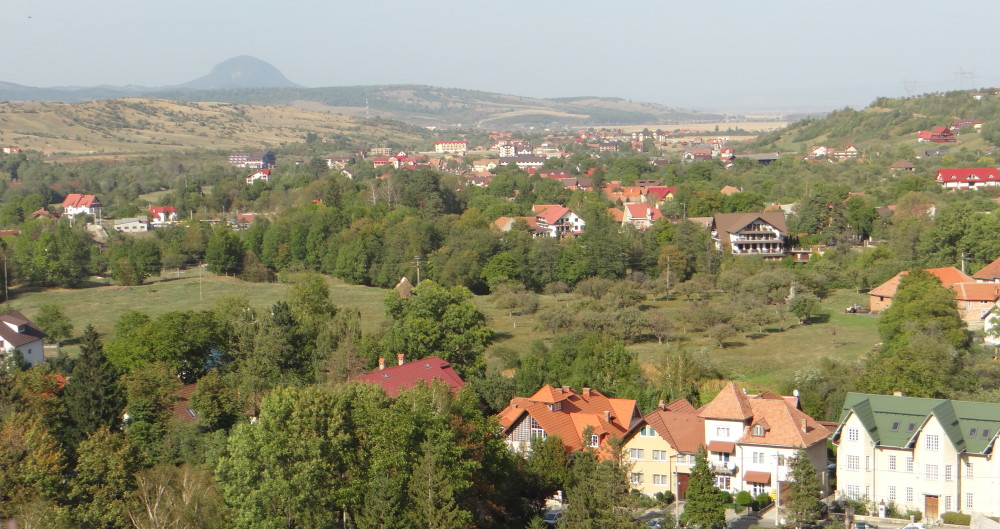“I had many occasional and strenuous coadjutors in debate, and one most steadfast, able, and zealous. . . . This was George Mason, a man of first order of wisdom among those who acted on the theatre of the revolution, of expansive mind, profound judgment, cogent in argument, learned in the lore of our former constitution, and earnest for the republican change on democratic principles.” – Thomas Jefferson, 1821

Gunston Hall Main Entrance (Photo: Ileana 2015)
As a naturalized American by choice, Independence Day for me is not “Happy July 4,” as young and old alike greet each other with all day, or an opportunity to grill, BBQ, be with your family and friends, hang out the flag with pride, or ignore it because it’s a misperceived symbol of racism, or burn it just because you can, or attend fireworks shows for the sake of traditional entertainment.
Independence Day has a deep significance that only people like me who fled evil communism or other dictatorships can understand and few can explain cogently. For me, it is the story of the valiant fight for freedom and independence from an oppressive and out-of-control government.
On this hot and humid 239th Independence Day anniversary, I decided to take a trip down history lane, about four miles east off the beaten path to Gunston Hall. The road wound through lovely pastures, a hidden golf course, a state park, a couple of churches, and thick-forested areas that seemed a world away from the busy highways and interstates of northern Virginia.
On the site of the first Pohick Church (1730-1774), one of the earliest religious sites in Fairfax County, there is a lovely Methodist Church nestled among green trees and pastures, the Lewis Chapel/Cranford Memorial, built in 1857, surrounded by graves dating back to 1780. A simple engraved granite block memorializes “all soldiers who served in the Civil War, 1861-1865, and were buried here.” A few American flags are visible, vases with artificial flowers, but not one Confederate flag is displayed.
When Daniel French, the original contractor that was hired to build the new Pohick Church died during its construction in 1771, George Mason, an executor and vestryman, finished the job.
Documents reveal that in the period prior to the Revolutionary War, Anglican churches, which were supported by taxes, fulfilled the function of welfare agencies, taking care of the poor, the widowed, and of the orphans.
A historical sign described how on June 16, 1700, unknown Indians, possibly “Wittowees or Piscataways,” attacked with “arrowes and wooden Tommahawkes” and killed eight people in Thomas Barton’s house. Historians speculated that the attack occurred because the Indians were upset by colonial encroachment on their lands and were “encouraged” by the French.
Gunston Hall, located about four miles to the east, was George Mason’s home, the Revolutionary leader and author of the Virginia Declaration of Rights and the first Constitution of Virginia. The fourth George Mason built his mansion in 1755-1758, but the land had been “acquired” in 1696 by the second George Mason. He bought the land which was patented in 1651 by Richard Turney. Turney was hanged for taking part in the Bacon’s Rebellion in 1676.
The winding entrance to Gunston Hall is flanked by thick woods until it suddenly opens wide into grassy fields. The majestic road is lined by old magnolias. The original cherry trees from George Mason’s time had been replaced long ago with stately magnolias.
To the left of Gunston Hall, about three-fourths of a mile, the Potomac River adds a marine blue hue to the lush green landscape. A road leads to the port where boats docked and delivered visitors and cargo to the mansion. A beautiful garden path in the back of the house is lined with the original bushes, leading to a bluff overlooking a forested valley.

Original well used by the Mason Family (Photo: Ileana 2015)
The original 18th century well used by George Mason’s family is still on the left hand side of the property. In a shed behind, inhabited by a black snake which startled me when I reached too deeply inside to take a photograph, there is an 18th century millstone found near the site of Holt’s Mill (operational from 1700-1740 on Mason lands) one mile southwest of Gunston Hall on Mill Creek. Thirty other buildings and barns surrounded the mansion at the time. It was a lively village bustling with activity.
As it was the case with most wealthy land owners in the 18th century Virginia, George Mason planned and supervised the construction of his own home, designing its exterior and layout with the help of an English-trained carpenter and joiner, William Buckland, whom he hired in 1755.
A wealthy Virginian’s mansion was literally his castle for dinners, teas, balls, barbecues, fish frys, games, hunts, and musical entertainment. Ever so hospitable, neighbors, relatives, and friends and “visitors of distinction” were frequent guests and always welcome. Entertaining all the time was a way of life.
John Mason, the eldest child, recalled that the main meal was served at 2 p.m. and nobody sat down until his father arrived. Grace was always part of the meal, “God bless us, and what we are going to receive.”
A devoted husband and father, George Mason was married to Ann Eilbeck for twenty-three years. When she died at thirty-nine, he described his beloved wife as “a prudent & a tender mother.”
As a Justice of Peace, George Mason signed marriage licenses. He mused in a letter, “This cold weather has set all the young Folks to providing Bedfellows. I have signed two or three Licenses every Day since I have been at Home. I wish I knew where to get a good one myself; for I find cold Sheets extremely disagreeable.” He remained a widower for seven years before marrying a second time to Sarah Brent of Woodstock in Stafford County. There are many Brents today in Dumfries, the oldest town in Virginia.
George Mason was only a delegate to the Virginia Assembly, a Justice of Peace for Fairfax County, a vestryman at Pohick Church, and a trustee for the towns of Alexandria and Dumfries, but he had a profound influence on our nation’s government.
George Mason had 12 children by Ann Eilbeck. The nine (five boys and four girls) who survived were educated by a private tutor in a one-room school built for them on the property. Tutors included a Mr. McPherson of Maryland and a Mr. Davidson and a Mr. Constable of Scotland. In 1832, Gen. John Mason described how the last two tutors had been specially selected by George Mason himself to come to America in order to teach his large brood while they lived in his house. The entire second floor of the mansion was dedicated to bedrooms for the children with beautiful views of the lands, including a spectacular view of the Potomac River and of the gardens.
The first floor had a large entrance atrium with a beautiful grand wooden staircase, the deep-green master bedroom to the left and a dining room in green, white, and gold, with George Mason’s portrait and the portrait of his first wife Ann as a sixteen year-old, a Chinese-motif room, painted in yellow and decorated with pagoda-like freezes and wooden moldings as envisioned at the time. Closets, hallways, another staircase, helix-shaped and tiny, a game room, and reading room completed the floor.
 Slaves working quarters (Photo: Ileana 2015)
Slaves working quarters (Photo: Ileana 2015)
Slaves lived away from the main house, as Mason wrote, “Out of sight, was a little village called Log-Town – so called because most of the houses were built of hewn pine logs. . . . lived here several Families of the slaves, serving about the Mansion house – among them were my Father’s body Servant James, a Mulattoe Man & his Family, and those of several Negroe carpenters.” Some outbuildings near the main house were places where slaves worked, ate, and sometimes slept.
Slaves grew tobacco and wheat for export, some were blacksmiths, carpenters, coopers, shoemakers, spinners, weavers, others were domestics in the Mason household, cooking, raising children or were personal butlers. In 1783, according to archives, “more than half of Virginia’s population was black.” It is fair to say that “slavery was the dominant form of labor in Virginia” of the 18th century.
According to the archives, even though George Mason described slavery as a “slow poison,” he did not free his 90 slaves. When he died in 1792, he willed his slaves to his nine children. Some Chesapeake slave owners did emancipate their slaves. Few runaways made it to freedom; George Mason issued a reward of ten pounds for the return of his slaves, offering detailed descriptions of the men and the possessions they carried with them.
The last private owners of Gunston Hall, Louis and Eleanor Hertle, donated the mansion in 1949 to the Commonwealth of Virginia, administered by a Board of Regents from the National Society of The Colonial Dames of America in Mrs. Hertle’s memory. Louis Hertle, retired from her job at Marshall Field’s in Chicago, hired architect Glenn Brown to restore the mansion beginning in 1912.
According to the museum archives, aside from the few volumes with George Mason’s signature, acquired from his uncle and guardian, John Mercer, a lawyer with a vast collection of 1,700 books, little is known about Mason’s library. He was quite wealthy and we know that he gave each of his children a substantial gift of money and property.
A 1775 ledger with Jenifer and Hooe, a merchant firm of Alexandria, revealed that George Mason was growing a lot of wheat on his property after 1770. Prior, tobacco was the primary crop. In a September 1788 letter, George Mason wrote: “A violent Storm of Wind and Rain . . . with almost Continual Rain for many Days afterwards, has done great damage to the Tobacco . . . our wheat has also suffered some Damage, & our Hay a great deal . . .” Tobacco was grown in 1775 on his Hallowing, Occoquan, and Dogue plantations.
Virginia planters, including Mason, grew tobacco, wheat, and corn for sale, barley, cotton, corn, and flax for private use. An orchard provided fruits and nuts and a 1780 letter to Thomas Jefferson shows that “Mason took great interest in his fruit stock.” Every plantation had an extensive garden to feed everyone. Tallow, leather, and wool came from animals they raised. Fishing and hunting provided both food and recreation.
George Mason, the author of the Virginia Declaration of Rights, influenced many other authors and documents:
– Thomas Jefferson when he wrote the Declaration of Independence
– James Madison when drafting the U.S. Bill of Rights
– Benjamin Franklin when drafting the Pennsylvania constitution
– John Adams when drafting the Massachusetts constitution
– An adaptation of Mason’s first Article, “That all Men are by Nature equally free and independent, and have certain inherent Rights, of which, when they enter into a State of Society, they cannot, by any Compact, deprive or divest their Posterity; namely, the Enjoyment of Life and Liberty, with the Means of acquiring and possessing Property, and pursuing and obtaining Happiness and Safety,” appears in Wisconsin, South Dakota, and Montana constitutions
– The French Declaration of the Rights of Man
– The United Nations Universal Declaration of Human Rights
George Mason, Elbridge Gerry, and Edmund Randolph were the Constitution non-signers among the fifty-five delegates, each calling for a national bill of rights. Mason wrote prophetically at the conclusion of the 1787 federal convention in Philadelphia (mid-May through mid-September): “There is no Declaration of Rights, and the law of the general Government being paramount to the Laws & Constitutions of the several States, the Declaration of Rights in separate States are no Security. Nor are the people secured even in the Enjoyment of the Benefits of the common Laws.”
As one of the primary architects of the Constitution, having delivered more than 125 speeches during the convention, but “fearing that the proposed government would diminish the power vested in the citizenry,” George Mason refused to sign. His prophetic decision was made in the Philadelphia State House, known as Independence Hall, where the Federal Convention met.
Thanks to George Mason’s 1776 Virginia Declaration of Rights, the English Bill of Rights of 1689, and the Magna Carta (1215), we now have The U.S. Bill of Rights which includes freedoms not enumerated in the Constitution such as freedom of religion, of speech, freedom of the press, of assembly, the right to keep and bear arms, freedom from unreasonable search and seizure, security in personal effects, freedom from warrants issued without probable cause, and reserves all powers not specifically granted to the federal government to the people or the States. The question remains, are we going to be able to keep them?
ILEANA JOHNSON
American By Choice

Congratulations on your American citizenship! I’m so very proud of you! Your article is very well written, both in your historical references and description of Gunston Hall as well as your comments about the freedoms that we Americans enjoy. Your question concerning our ability to keep them is a major issue today! I would like to share your first paragraph about our freedoms and your last paragraph about our freedoms and your question about our ability to keep them. Do I have your permission to publish your 2 paragraphs on my Facebook page?
Thank you for a wonderful article and for your bravery and determination to add your energy and special talents to your new country!
Gratefully,